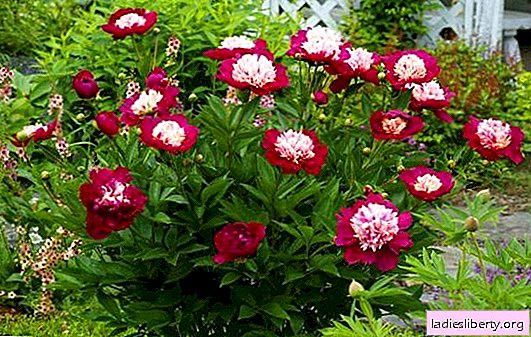
Peonies, one of the most popular ornamental plants, will become a magnificent decoration of any garden. Their spectacular bright flowers with a delicate aroma look great against the background of dark green leaves.
Thanks to the unpretentiousness, longevity and frost resistance of peonies, even a beginner grower can grow these beautiful flowers.
Planting peonies in the open ground (photo)
How to choose a place in the garden for peonies
To determine where to plant these flowers in your area, it is important to know the following nuances:
1. Perennial peonies can be grown in a permanent place without transplanting for several years. However, despite the unpretentiousness, to obtain lush flowering, you should still take into account some of the nuances when planting peonies in open ground. It is undesirable to plant them along fences, walls of buildings, since they need space and good lighting.
In the shade, peonies stretch out, flower stalks bend under the weight of flowers and break. Most often, under such conditions, the plant ceases to bloom altogether.
If you plant peonies on the south side of the site, then the flowers will quickly fade in the sun. Therefore, the best option for their placement will be open slightly shaded areas that are protected from the wind;
2. In terms of soil composition, light loams with a slightly acidic reaction (pH = 5.5-6.5) are optimal for pions. Before planting, heavy clay soils must be "ennobled" - add coarse sand, dolomite flour or lime (1 kg / m2). If sandy loam prevails on the site, then clay is added to them. In both cases, rotted manure or compost is added to increase soil fertility;
3. Depth of groundwater: at a high level (1 m and above), it is necessary to drain the site.
Peony planting dates
Peonies are planted mainly in the fall, and in rare cases in the spring. The optimal landing time is from the second half of August to the second week of September. Before the onset of frost, seedlings have time to grow young sucking roots and grow stronger.
In spring, peonies are planted after the snow melts, before the buds start to grow. If you plant already with awakened buds, then such a plant will lag behind in development from seedlings planted in the fall.
Peony Planting Technology
Due to the fact that the peony bush will grow in one place for several years and grow, you should plan 1-2 m2 of planting area for each plant. Digging holes dig a depth of 50-60 cm and a diameter of 70-80 cm.
Drainage from large expanded clay, crushed stone or broken brick is poured to the bottom of the hole.
Then a mound is poured from a mixture of excavated earth mixed with rotted manure or compost (5-6 kg), wood ash (0.5 liter can) and potassium phosphate fertilizers (for example, 100 g of potassium sulfate and double superphosphate).
The seedling is lowered into the pit, the roots are straightened, directing them down, and covered with the remaining soil. In this case, the growth point is buried by 3-5 cm. With a deeper planting, the plant will be weak, prone to frequent diseases, flowering will be sparse or absent altogether.

Peony planting: 1 - drainage; 2 - mineral-organic earth mixture; 3 - garden land; 4 - the depth of the neck of the seedling
In order not to be mistaken with depth, it is convenient to use a landing board or stick. It is placed across the hole and measure the desired length value.

Using a stick to determine the depth of planting of a peony seedling
After planting, the plants are watered, spending 10 l of water for each. In this case, the soil settles, so the hole is sprinkled with earth and mulched with peat or straw.
How to propagate peonies
There are several ways to propagate peonies.
Seed method used in breeding to produce new varieties. In addition, plants grown from seeds do not retain the varietal characteristics of "parents" and bloom for 6-7 years of vegetation.
Layering thriving adult bushes can be propagated. For this, the bush, as the shoots grow during the season, is 2-3 times spouted to a height of 30-4 cm, watered and fed plentifully.

Spouted Peony Bush
The buds on such stems are removed. Such events will give the plant the opportunity to lay flower and vegetative buds and form thin roots on the lower part of the stems. At the end of August, the land around the shoots is carefully raked, they are separated from the mother plant and transplanted into a box or greenhouse. For the winter they are covered with mulch (straw, peat). In the flower beds they plant them in a year.
Cuttings rare varieties breed. At the same time, you can get a lot of planting material from one plant (15-35 cuttings). Harvesting is carried out from bushes older than 4 years 10-15 days before the start of flowering. The optimal period for cuttings is from the end of May to the middle of June. Each stalk should have 2 internodes.

The scheme of cutting cuttings from stems of peony
For better rooting, the cuttings are incubated for 7-8 hours in a solution of heteroauxin or root, and after that they are inclined into the greenhouse to a depth of 3-4 cm and at a distance of 7-10 cm from each other. The first 10-15 days they are sprayed 3 times a day. Rooting occurs after 1.5-2 months. Before wintering, seedlings are mulched with peat, sawdust, shavings, cut straw.
Bush division - The simplest and most effective way of propagating peonies. The best period for this is from August 15 to September 10. They share bushes that grow in one place for more than 8 years. This procedure also rejuvenates them.
The selected plant is dug up from all sides with garden pitchfork (root trauma will be less than when using a shovel) and carefully pull the bush out of the ground. The ground is shaken from the rhizome, and its remnants are washed off with water from a watering can or hose. After that, the dug bush is left to dry in a dry place for 3-5 hours. Before dividing the tops, they cut to 10-15 cm.
The rhizome is divided into parts so that each of them has 2-3 growth buds on the root neck and at least 15 cm long roots. The cuts on the roots are dusted with charcoal powder and left to dry. Then they are planted in a prepared place.

Peony bush division
Peony care in the open ground (photo)
Even a novice in floriculture can take care of peonies. During the period of active growth in spring, budding and flowering peonies need constant plentiful watering. On one bush spend 1-2 buckets of water at a time. Peonies are watered every 10 days until the end of summer. After watering the earth in near-stem circles loosen.
Peonies love good nutrition, which differs depending on the age of the plants.
Young peonies (up to 3 years old) when planting which nutrients were added to the planting pits do not need additional root dressing. To build leaf mass in the spring during the emergence of seedlings, you can spray with a solution of complex fertilizers. Repeat after 2 weeks.
If planting technology has been violated, then dressing will have to start in the first year of vegetation. In April, planting peonies is watered with a mullein solution (1:10) with the addition of 200 g of superphosphate and 300 g of wood ash. Instead, a “cocktail” can be used nitrofoska (100g / m2). The second feeding is carried out in mid-May. For the third time (in mid-June), phosphorus and potassium-containing preparations are added.
In adult flowering peonies, the need for nutrition is different. In the spring, they need nitrogen and potassium. Ammonium nitrate and potassium sulfate (60 g / m2) can be scattered around such bushes as such substances. The second time the plants are fed during the period of budding with complex fertilizers (Kemira universal, Agricola, etc.). After flowering, peonies are watered with a solution of phosphorus-potassium fertilizers.
Important! All top dressing is applied after watering the plants (except for those scattered in the snow).
Peony flower stalks have several buds. To achieve larger flowers, side buds are plucked. Due to this, the central flower will be large. Often the stems do not support the weight of blossoming inflorescences and bend to the ground. Therefore, it is necessary to establish a circular support around the bush in order to avoid its collapse.

An example of a circular support for peony bushes
Faded flower heads are periodically removed.
After the plant completely fades and loses its decorativeness, we would not like to, but you do not need to cut the tops. During this period, peonies begin laying new buds, and the presence of leaves for photosynthesis is very important at this time.
Only in autumn, when massive yellowing of the ground part of the bush occurs, it is cut to 10-15 cm from ground level.
After that, young plants are mulched with peat or chopped straw. Adult plants do not need shelter.











